|
|
|
Sort Order |
|
|
|
Items / Page
|
|
|
|
|
|
|
| Srl | Item |
| 1 |
ID:
138934


|
|
|
|
|
| Summary/Abstract |
This article proceeds from a photograph. It does so to begin an investigation of the diverse sites within and beyond it, and the reflections of several enactments of nation, culture, belonging and non-belonging. The image in question depicts a group of children waving flags. It is an old photograph, possibly removed from our ‘present’, though it holds within it multi-temporal spaces into which we might enter. The aim of this article is to do just that – to enter the image, armed with all the things a researcher gathers in terms of background data, narratives and contexts, and examine the complex negotiations enacted within and beyond it. How does this group of flag-waving children impact on us today? This article explores the extent to which an understanding of a temporal enactment of nation in displacement might reflect on contemporary negotiations of citizenship, culture and representation.
|
|
|
|
|
|
|
|
|
|
|
|
|
|
|
|
| 2 |
ID:
116446
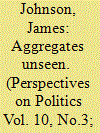

|
|
|
|
|
| Publication |
2012.
|
| Summary/Abstract |
Photography, understood as a technology for amplifying imagination, affords a useful tool for coming to terms with the massive forced migration caused by the Katrina catastrophe. Specifically, photographic projects by Robert Polidori and Richard Misrach reveal the exigencies of communicating in the wake of the disaster.
|
|
|
|
|
|
|
|
|
|
|
|
|
|
|
|
| 3 |
ID:
172224
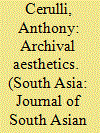

|
|
|
|
|
| Summary/Abstract |
Can the Indian manuscript and manuscript library be art? In what follows, I reflect on this question by examining a set of photographs I created for an art project called Manuscriptistan. I explain what it has meant for me to aestheticise Indian manuscript libraries and manuscripts, and I offer some insights about why it is important for scholars to bring sensual, spatial and artistic awareness to the things with which, and the spaces in which, they do their research.
|
|
|
|
|
|
|
|
|
|
|
|
|
|
|
|
| 4 |
ID:
143657
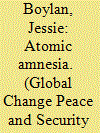

|
|
|
|
|
| Summary/Abstract |
This paper addresses the ways in which photography can illuminate that which is unfathomable, such as nuclear catastrophe. It discusses how chronicling the nuclear era through art can allow us to break free of our atomic amnesia and urge us to imagine possible alternative futures free of nuclear disaster. It examines the ways in which members of the Atomic Photographers Guild have sharply focused on all aspects of the nuclear age and its fallout.
|
|
|
|
|
|
|
|
|
|
|
|
|
|
|
|
| 5 |
ID:
178334
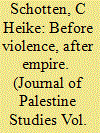

|
|
|
|
|
| Summary/Abstract |
Ariella Aïsha Azoulay’s new book, Potential History: Unlearning Imperialism, offers a rethinking of violence and modernity that presents collaborative, reparative forms of world building as the only viable means of resisting and overcoming the ravages of imperialism. The book is at once a reckoning with empire, a semiautobiographical theorization of complicity, and a magnificent analytic exposé of imperial technologies of knowing, including photography, art, archives and museums, history, sovereignty, and human rights.
|
|
|
|
|
|
|
|
|
|
|
|
|
|
|
|
| 6 |
ID:
121822
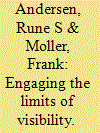

|
|
|
|
|
| Publication |
2013.
|
| Summary/Abstract |
In this article, we introduce selected photographs in order to engage with their capability for questioning the representational codes dominant in the visualization of security policy and surveillance. We argue that the intangible, abstract workings of state power in connection with security, surveillance and current forms of warfare can aptly be represented and challenged by means of photography. By engaging the limits of visibility, the selected photographs explore the limits of photojournalism and security alike. First, they operate by making visible what is normally invisible, though they also blur the boundaries of the seen and the unseen. Second, they function outside the discursive-representational regime within which photojournalism, based on a powerful tradition, operates, and within which media and security professionals visualize security. By so doing, they avoid involuntary incorporation into and support of this very regime that simultaneously they help understand. Third, they visualize structures and institutions rather than people, thus avoiding ethical dilemmas in connection with representations of people in pain. Discussing selected photographs by Trevor Paglen and Simon Norfolk, we show what these photographs do to alter the discursive frame within which the politics of security is understood. Such alteration facilitates understanding of the extent to which current societies are penetrated by the ideas and practices of security and surveillance, and furthers investigation of the discursive structures that enable such penetration.
|
|
|
|
|
|
|
|
|
|
|
|
|
|
|
|
| 7 |
ID:
077355
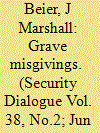

|
|
|
|
|
| Publication |
2007.
|
| Summary/Abstract |
Days after the December 1890 US Army massacre of Lakota refugees at Wounded Knee, South Dakota, commercial photographer George Trager photographed the Army burial detail as they cleared the site and committed the dead to a mass grave. Widely circulated as post-cards, Trager's photographs merged with a broader colonial narrative, allegorically and cathartically sketching a heroic account of a dire confrontation between `civilization' and `savagery'. Reconfirming dominant ideas about an inherently dangerous foe, the Wounded Knee photos worked through colonial imaginaries in ways that reinforced a Euro-American monopoly on legitimacy in war. More recently, widely circulated photos of abuse of prisoners by US soldiers at Baghdad's Abu Ghraib Prison have effected a disruption of the operant war narrative. Whereas Trager's photographs worked to sustain stable definitions of moral `civilization' and `savage' depravity, those from Abu Ghraib have undermined the legitimacy of US conduct in Iraq. In this article, I consider these differing effects with reference to photographic composition and the popular functions of allegory and catharsis
|
|
|
|
|
|
|
|
|
|
|
|
|
|
|
|
| 8 |
ID:
185179
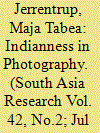

|
|
|
|
|
| Summary/Abstract |
This article explores the question whether there is a specifically Indian style of photography. A survey of photography students from various institutions revealed that though there is little clarity about the actual look of an Indian style of photography, students clearly define their own photographs as Indian. Intriguingly, the focus is less on certain visual characteristics, but more on the feelings they derive from the photographs, a scenario which is reminiscent of the rasa theory. Even though this was hardly mentioned by the students, this psycho-social element seems to have left a cultural imprint but also reflects an act of claiming ownership and agency. In addition, the students identified alienating aspects in photography, such as seeing one’s own culture like an outsider, but at the same time consider it to be integrating, since photography paves the way for a deeper engagement with one’s own culture, and as such strengthens Indianness.
|
|
|
|
|
|
|
|
|
|
|
|
|
|
|
|
| 9 |
ID:
096947
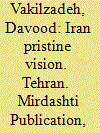

|
|
|
|
|
| Publication |
Tehran, Mirdashti Publication, 2006.
|
| Description |
152p.
|
|
|
|
|
|
|
|
|
|
|
|
Copies: C:2/I:0,R:0,Q:0
Circulation
| Accession# | Call# | Current Location | Status | Policy | Location |
| 054924 | 720.55/VAK 054924 | Main | On Shelf | General | |
| 055103 | 720.55/VAK 055103 | Main | On Shelf | General | |
|
|
|
|
| 10 |
ID:
046674
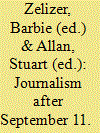

|
|
|
|
|
| Publication |
London, Routledge, 2002.
|
| Description |
xiii, 268p.
|
| Standard Number |
0415288002
|
|
|
|
|
|
|
|
|
|
|
|
Copies: C:1/I:0,R:0,Q:0
Circulation
| Accession# | Call# | Current Location | Status | Policy | Location |
| 045894 | 070.433/ZEL 045894 | Main | On Shelf | General | |
|
|
|
|
| 11 |
ID:
164284
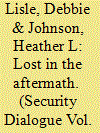

|
|
|
|
|
| Summary/Abstract |
What happens when violence disappears? What is left in the backwash of crisis? Who attends to the emotional, material and ideational detritus of closing borders? Like many, we are working in the aftermath of the recent and deadly intensification of EU migration. We contest the widespread account that the ‘crisis’ is now over – that policymakers have effectively ‘solved’ the problem of migration by gathering undocumented subjects into infrastructures of containment. We focus instead on the painful traces of EU migration that continue to be produced by global structures of citizen/alien, legal/illegal, friend/enemy. We do not produce a comprehensive diagnosis, normative argument or critical framework. Instead, we rest awhile in the aftermath of the crisis – specifically on the Greek island of Kos – to think about questions of abandonment, erasure and displacement. This is a visual essay representing a conversation between two researchers as they interact with the aftermath of the refugee crisis on Kos. Reflecting on select images from September 2016, we present a dialogue that directly speaks to a core theme each image raises. In doing so, we question some of the basic assumptions about how to do critical analysis on migration, security and borders, and therefore seek to disrupt dominant modes of academic writing as well as the practice of research itself.
|
|
|
|
|
|
|
|
|
|
|
|
|
|
|
|
| 12 |
ID:
178769
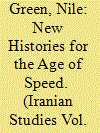

|
|
|
|
|
| Summary/Abstract |
By conceiving two emergent nation-states as a single region linked by conjoining roads, shared technologies and circulating researchers, this essay traces the emergence of a common “intellectual infrastructure” that during the interwar decades enabled European, American, Iranian, Afghan and Indian scholars to promote archeological and architectural interpretations of the Iranian and Afghan past. Taking Robert Byron’s Road to Oxiana as a fixed point of reference, the following pages survey the motor-linked sites where these new disciplinary approaches were developed and disseminated. By positioning Byron amid a larger cadre of investigators publishing in Farsi, Dari and Urdu no less than English, French and German, the essay shows how shifts in Iranian perceptions of the ancient and medieval past were part of a larger regional development, unfolding not only in familiar dialogue with Europe, but also in conversation and to some degree competition with nationalist scholarship in Afghanistan and India. Together with the journals, museums, learned societies and congresses which were launched in the 1920s and 1930s, cars and cameras—those key tools of the “age of speed”—were central to these learned ventures. Far from generating uniformity, this shared intellectual infrastructure enabled multiple interpretations of the archaeological and architectural past that were nonetheless mutually intelligible and methodologically consistent.
|
|
|
|
|
|
|
|
|
|
|
|
|
|
|
|
| 13 |
ID:
078774
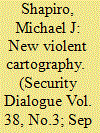

|
|
|
|
|
| Publication |
2007.
|
| Summary/Abstract |
Mapping the `new violent cartography', an inter-articulation of geographic imaginaries and antagonisms, based on models of identity-difference, this article begins with the analysis of a piece of photo-journalism, an image of a US soldier in a bombed-out bunker during the war in Afghanistan, and goes on to trace the institutions that are part of the contemporary aspects of militarization and securitization constituting the `war on terror'. The article ends with an analysis of the anti-war impetus of cinema and the cinematic spaces of film festivals
|
|
|
|
|
|
|
|
|
|
|
|
|
|
|
|
| 14 |
ID:
164398
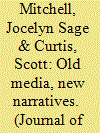

|
|
|
|
|
| Summary/Abstract |
In 1959, a Danish anthropological expedition to Qatar created hundreds of photographs and a 16-minute film depicting the diversity of Qatari lifestyles, which included strong evidence of a Bedouin past, separate from the merchant and pearl-diving culture of the coast. However, Qatar’s new national museum, still under development, has been working on a different narrative: a more unified national identity that emphasizes the similarities of Qatari heritage rather than the differences. Artifacts such as these photos and film can become inconvenient when they do not fit new and improved civic myths, yet as some of the most important (and well known) surviving images of Qatar’s heritage, this evidence cannot be left out. How might the museum make use of the evidence so that it aligns with its narrative? Here we focus on the aesthetic style of Jette Bang’s photographs and film, which emphasizes the warmth, hospitality, and universal humanity of Qatari heritage. Our argument connects the historical and ideological contexts for both the new national museum’s push for a unity narrative and Bang’s 1959 photographs and film. We suggest that the artistic elements of these ostensibly scientific and historical artifacts may offer Qatar’s new museum a way to repurpose them without jeopardizing a narrative of national unity.
|
|
|
|
|
|
|
|
|
|
|
|
|
|
|
|
| 15 |
ID:
177683
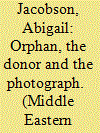

|
|
|
|
|
| Summary/Abstract |
This article uncovers the short history of the American Colony Christian Herald Orphanage, operating in Jerusalem following the First World War. Hosting around 36 Christian and Muslim girls, the orphanage relied on the financial support of the American-based Christian Herald newspaper. Through the close analysis of this institution, and the comparison with a Jewish orphanage in Jerusalem, the article will critically discuss the links between humanitarianism and photography. The sources used are an annotated photograph album documenting life in the Orphanage, as well as the Record Book documenting the girls who received support through the orphanage. Using these visual materials, the article addresses the ways photographs were used as part of fund-raising, missionary work and relief efforts in the context of Mandatory Jerusalem, and discusses the complex relationship between the orphan girl, the donor who supports her, and the way this relationship is constructed in the photograph.
|
|
|
|
|
|
|
|
|
|
|
|
|
|
|
|
| 16 |
ID:
077351
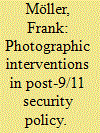

|
|
|
|
|
| Publication |
2007.
|
| Summary/Abstract |
Regardless of its cultural and discursive turn, the field of security studies has not yet paid sufficient attention to visual culture. In particular, approaches that focus on the articulation of security have been quite inattentive to images. With respect to post-9/11 security policy, it is argued here that the images of planes crashing into the World Trade Center have become not only a legitimacy provider for security policy but also part of every person's visual reservoir and pictorial memory, on which the successful articulation of security in part depends. It is therefore suggested to link the study of securitization with the study of both images and pictorial memory. The present article, by discussing three visual projects revolving around 9/11, looks for desecuritizing potential in photography and examines the extent to which photography can offer oppositional interventions in security policy. However, the surplus meaning that images inevitably carry with them, while limiting the securitizing potential of images, also reduces the extent to which opposition can rely on images
|
|
|
|
|
|
|
|
|
|
|
|
|
|
|
|
| 17 |
ID:
092449
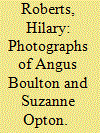

|
|
|
|
|
| Publication |
2009.
|
| Summary/Abstract |
In comparison to some media, such as sculpture or painting, photography has a relatively short history.
|
|
|
|
|
|
|
|
|
|
|
|
|
|
|
|
| 18 |
ID:
112532
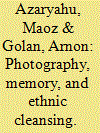

|
|
|
|
|
| Publication |
2012.
|
| Summary/Abstract |
Much of the recent academic literature on the 1948 war portray it a one-sided-and thus simplistic-ethnic cleansing of the Arab population of Palestine. Referred to as the Naqba paradigm, it features the Jews/Zionists as villainous perpetrators and the Palestinian Arabs as feeble victims. Accordingly, the story of "the 1948 Ethnic Cleansing of Palestine" excludes expulsion and massacres of Jews, the destruction of Jewish communities, and the erasure of the Jewish signifiers in the local landscape from the story. As made explicit in John Phillips' photo-reportage featuring the destruction of the Jewish Quarter of the Old City of Jerusalem, the ethnic cleansing of Palestine also involved the expulsion of Jews and the destruction of their communities-whenever and wherever military power relations were in favor of Arab forces.
|
|
|
|
|
|
|
|
|
|
|
|
|
|
|
|
| 19 |
ID:
114182
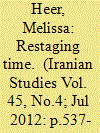

|
|
|
|
|
| Publication |
2012.
|
| Summary/Abstract |
This paper looks at a group of photographs entitled Qajar Series (1998) by artist Shadi Ghadirian. Ghadirian recreates sets to look like those used in photographic portraits taken during the late nineteenth and early twentieth century of the Qajar dynasty period and dresses her female sitters in costumes reminiscent of clothes from the era. The artist also integrates contemporary objects that do not fit within the historical setting created for the camera. This essay examines how the artist uses performance to stage this anachronism and think critically about temporal discourses and their links to the categories of modernity and tradition.
|
|
|
|
|
|
|
|
|
|
|
|
|
|
|
|
| 20 |
ID:
182939
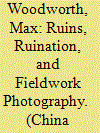

|
|
|
|
|
| Summary/Abstract |
This article offers a self-reflexive critique of ruins as method by examining side-by-side the production, circulation, and meaning-making processes around the ruin photography of ghost cities in China and the author’s own production of a fieldwork archive of the same photographed spaces. The ruin is commonly understood in recent scholarship to be a deeply ideological artefact with meanings contingent on class-inflected practices of ruin appreciation. In a similar vein, photography of urban ruins has been heavily criticised for allegedly aestheticising social ruin and economic decline. The critique of ruin photography as a practice of ideological claim-making or as a form of critical engagement merits scrutiny in light of this issue’s field research practices looking at ruins in China. More specifically, photography is a standard part of fieldwork, including the author’s. The aim of this article, then, is to ask how and why photographs of urban ruins in China differ across image-making practices? How are fieldwork photos of ruins, the kinds of photos that generate a data archive and are used in scholarly publications, resonant with other ideological claim-making purposes of ruin photography? How might we account for the political valences of image aesthetics when photographs are a vital part of scholarly efforts?
|
|
|
|
|
|
|
|
|
|
|
|
|
|
|
|
|
|
|
|
|